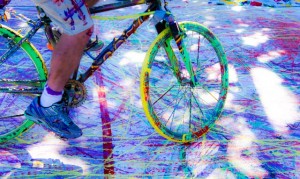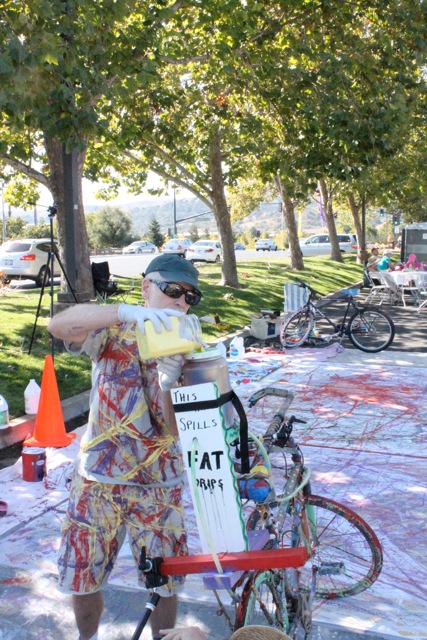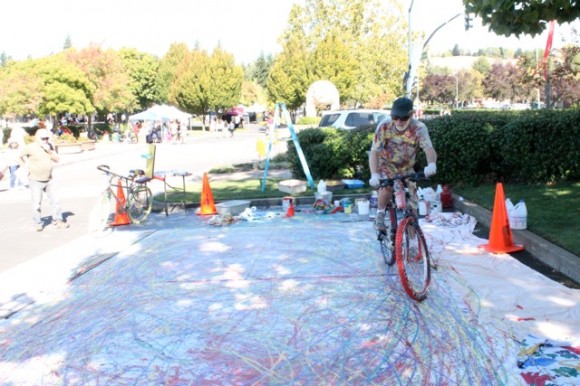aNewDomain.net — Our John A. Barry and Bill Carmel do a deep dive on trAction Painting, a fascinating new art medium near to their hearts — and arts — for a reason. This is a lot more than just bike painting. Check out trAction Painting as they conceive it. Gallery below.
History shows us that most academies and schools of art have been built around tradition. Frequently, new ways of perceiving the world and the resulting visual works of art by a few seminal artists are, at first, rejected by the establishment. Then there is a period when more artists experiment with the new techniques for making visual imagery. Artists show their work in experimental exhibitions, more artists experiment and exhibit, and the new style goes viral in the art and cultural community.
Gradually the new style is taught in schools and academies and adopted by the general public. Impressionism is a good example of this. Cubism, surrealism and abstract expressionism are others.

Some schools and studios are founded on and become devoted to new ways of making visual imagery by pushing the boundaries of how art is defined and incorporated into culture and history. Traditional ideas and methods blended with contemporary points of view were the foundation for the bauhaus in Germany — and the arts and crafts movement in the United States, for instance.
Image credit: John Barry
Photography was invented in the middle of the nineteenth century and immediately became the preferred method of documentation and means of visual communication. Because it replaced portraiture and “realistic” representation and styles, the then-new medium created a conflagration in the art communities.
It meant that anyone could make, record, and sell less-expensive, visually-accurate images of people, places, and things. The use of the camera and photographic media has been feared, ridiculed, and shunned by artists ever since. Even today it is possible to see calls for entries to juried artistic exhibitions that forbid or restrict photographic processes — including digital ones.
The way a few artists dealt with the invention and widespread adoption of photography by the corporate design world and the general public was to invent new styles that incorporated imagery unlike what the camera could produce. Once impressionism became accepted by enough artists, the strategy of many in academia and the fine art industries became “anything but realism,” concentrating instead on the non-traditional aesthetics of the art establishment that promotes “art for art’s sake.” Artists challenged and built upon these styles and points of view, creating almost as many stylistic variations as there were artists.
For the most part, the fine art industry has ignored photorealistic imagery during the past century, even though the general public can’t seem to get enough of it. Now it seems that the stylistic wheel has turned as more artists incorporate imagery that looks realistic and embraces digital technology. Technological advances in cameras and photographic processes have evolved into digital imaging devices whose hardware and software give artists a dizzying array of ways to blend techniques for creating images in two and three dimensions. The digital camera, assisted by such applications as Photoshop, can be employed as a tool in the process of making stunning and exciting visual images. To create action videos with a sense of immediacy and kineticism, GoPro and similar high-def cameras can be mounted on skateboarders’ helmets and bike racers’ handlebars, for example.

Today’s high-end bicycles, to which high-def cameras are then attached, become marvels of materials and digital technology.
Carbon-fiber frames and components make for two-wheeled vehicles that weigh not much more than a set of fenders on a balloon-tire clunker from the 1950s.
Wireless computers measure everything from distance traveled to a rider’s heart rate.
You could spend ten grand and more on one of these bikes, which, in many senses, bear no resemblance to early bicycles.
The image at left depicts John Barry setting up for trAction Painting and loading the paint dispensor on board. Image courtesy: John Barry for aNewDomain.net.
Yet Bikes Evolve While Remaining the Same …
In 1817 Romanticism—after being rejected by Classicism—was in full flower in Germany. That’s when Baron Karl von Drais invented a “walking machine” that had two same-size inline wheels, the front one steerable, mounted in a frame.
Von Drais propelled the contraption by straddling it and pushing his feet against the ground. Made entirely of wood, the device became known as the Draisienne, dandy horse or hobby horse.
Just before reviled-by-the-Academy Impressionism arrived, pedals appeared in France on the two-wheeled vehicle.
But they were applied directly to the front wheel. Known as the velocipede (“fast foot”), this pedal-propelled machine had another moniker: the boneshaker. It, too, was made of wood, with metal wheels added later.
These stiff materials, combined with cobblestone roads, resulted in a rough ride.
In the late nineteenth century, advances in metallurgy enabled the fabrication of chains to drive the rear wheel, and pneumatic tires softened the ride. But strictly as a means of transportation, the bicycle has remained essentially unchanged from then to the present. Everyone from riders of the boneshaker to contestants in the Tour de France moves forward by pushing their feet against pedals that drive a chain, which, in turn, drives the rear wheel. Click here for more on the history of the bike and its development.
Bicycle As Communication Medium
Bike messengers carry correspondence through concrete corridors in cataclysmic fashion. The medium is the message, the correspondence being carried; the bike the means of transport. We have turned that concept on its head—or at least around—so that the bicycle itself is the messenger and the medium, or at least the instrument by which the message is created.
The result is what we call trAction painting, the application of paint to large flat surfaces via bicycles and other wheeled conveyances. The bicycle, in effect, becomes a brush depositing paint on canvas, plywood, asphalt and other surfaces. The image below shows street bike trAction painting: courtesy John Barry, who is also the subject.

The name trAction Painting is based on the definitions of traction as “the drawing of a vehicle by motive power; the adhesive friction of a body on a surface on which it moves.”
The term is also a take-off on the term “action painting,” itself a phrase coined by American critic Harold Rosenberg in 1952, in his essay “The American Action Painters,” to describe the work of Jackson Pollock and other Abstract Expressionists. According to Rosenberg, the canvas is an “arena in which to act.”
So trAction Painting, a type of performance art, started as skainting, a portmanteau word combining skating and painting. John Barry created his first skainting solo, in his garage. Our first joint trAction Painting event occurred in April 2013, in a large gallery space. Bill Carmel helped direct the action, and Barry applied the paint. But this was still strictly a skainting event.
Next came “bainting” — that’s painting with bicycles — and, then, the evolution of the trAction painting genre.
I’ve completed four more trAction paintings, employing bikes, skates, and other wheeled conveyances. In October 2013, I finished a 12-foot x 22-foot canvas at an art fair. In addition to using two bikes. One utilized smooth street tires, as shown above; the other had mountain bike tires, producing a stippled track. With those bikes and inline skates, I also rolled on a layer with a two-wheeled walker.
In this performance, nineteenth and twenty-first-century technologies met in the form of GoPro-laden armatures extending from the bikes to record action for a video we are submitting to a bicycle-themed art contest. The pic below shows traction painting with a mountain bike: courtesy and subject, John Barry.

But this video project and all the solo performances to date represent the first phase in our goal of taking this show on the road.
Specifically, we want to develop and advance this art form as a communication tool for hooking kids and adults on the arts. We envision, for example, BMX ballets; synchronized “Schwinning”; tandem tableaux.
With the help of hardware and software techies, we’d like to develop, for example, paint dispensation microcontrollers with which an adept rider could select the color, the spray pattern for the wheel width and so on.
In these ways, trAction Painting challenges expectations of how art is made, by producing paintings using nontraditional methods: bainting, skainting, and other manifestations of what we call “Wheelism.” The picture below sh ows my work in progress.
ows my work in progress.
This unique way of creating art makes the activity of the process visible as dynamic and visually stimulating images.
Application of technology can be repurposed in unexpected but useful ways, and trAction is an example of such repurposing that, we hope, will spark an artistic flame among students.
Numerous studies have demonstrated the value of art in school to promote the development of everything from critical thinking to cognitive skills.
We see trAction painting as a mechanism for getting kids to think about art and, through it, make connections to new forms of expression that may be completely unrelated to trAction Painting per se.
An old joke goes: When is a door not a door? When it’s ajar.
When is a bicycle not a bicycle? When it’s a brush.
With the creation and development of trAction Painting, we believe we have merged the medium and the message to demonstrate how a technology can be reinvented to serve not only as a “reinvention” of the bicycle—from traction to trAction—but as an art education tool.For more on trAction painting as my team and I have conceived it, check out trAction-Painting.com.
For aNewDomain.net, I’m John A. Barry. Artist and educator Bill Carmel co-authored this story, original to aNewDomain.














This is a beautiful piece with amazing images. I wanna traction paint!